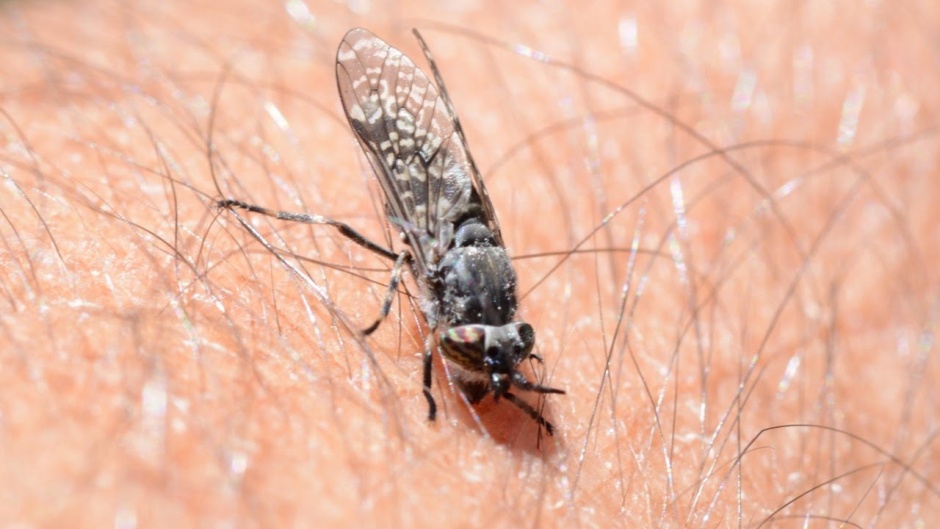Horseflies are similar to flies, but larger in size, with a thick body. The females have a complex buccal apparatus, with sharp, hard elements capable of piercing the skin in order to feed on their blood.
 Photo: Antonio Cruz.
Photo: Antonio Cruz.
I sent the (hornet) horsefly ahead of you, which drove them out before you—also the two Amorite kings. You did not do it with your own sword and bow. (Jos. 24:12)
The Hebrew term ʽa·róv is not easy to translate and, in fact, it is uncertain exactly which species of insect it refers to. It appears as the fourth plague of Egypt, which did not affect the Israelite inhabitants of Goshen (Ex. 8:21; Psalm 78:5; 105:31).
In different versions of the Bible, the term is translated as “flies”, “horseflies”, “mosquitoes”, “annoying insects”, “dog flies”, etc. Of course, one of the dipteran insect groups with the most painful sting is that of the horsefly, which is why many scholars prefer this translation.
Horseflies are similar to flies, but larger in size, with a thick body and large, green-tinted, shining eyes. The males do not harm humans, as they feed on vegetal juices. However, the females have a complex buccal apparatus, with sharp, hard elements capable of piercing the skin of horses, oxen, mules and, needless to say, people, in order to feed on their blood.
In certain African regions, there are so many horseflies that it is impossible to move around because of them. Hence, the fourth plague in Egypt was probably a plague of horseflies, so the Egyptians and their livestock must have suffered terribly, and many may well have died.
The horsefly family (Tabanidae) is made up of 4,500 species throughout the world, 1,000 of which belong to the Tabanus genus. They are dipteran insects, which means that they only have two functioning wings, as their rear wings are small and serve as halteres to balance them while they are flying. This enhances their effectiveness in flight, and can enable them to reach speeds of up to 30 km/h, in the case of species that live in fields and meadows.
When they bite mammals they inject them with substances that inhibit blood clotting, so that the blood can flow freely while they suck it. When the eggs are formed in the female horsefly’s ovaries, they usually lay them at the base of grass stems or on the surface of humid soil.
Due to this bloodsucking behaviour of female horseflies they are vectors or transmitters of certain pathogenic organisms. Some African species of the Chrysops genus can transmit to humans a nematode (Loa loa), a parasite causing a disease known as dermal filariasis, which generates tiny worms in the blood and under the skin that then migrate to the eyes.
In most cases, the horsefly’s bite is painful and causes the skin to become red and swollen, which requires treatment with antibiotics. They are insects which humid environments with abundant water, as it needs water-logged ground in which to lay its eggs, and also the presence nearby of large mammals. According to Greek mythology, horseflies were created by Zeus in order to kill the hero Bellerophon, who went up to mount Olympus, which mere mortals were forbidden to do.
It is in the fourth plague of flies, or horseflies (which, after all, are also flies), as related in Exodus 8:20-32, that the first distinction is made between the Egyptians and the Israelites. In fact, God’s chosen people had suffered, just like the Egyptians, the effects of the first three plagues. They had seen how the water of the Nile had turned red, making it undrinkable and killing the fish that were their source of food. They were witnesses to the plague of frogs which infested their houses too, leaving a foul smell when they died or were accidentally crushed underfoot. Likewise, they were subject to the bites of the mosquitoes that swarmed over Egypt in thick clouds.
However, when it came to the fourth plague, that of the horseflies, God placed his merciful hand over the inhabitants of Goshen and protected them (set them apart) so that they would learn who Yahweh was in the land that they inhabited. (Exodus 8 v 22).
Also in the New Testament, God’s heart is often revealed in the same light. God knows his own, just as a shepherd perfectly recognises each of his sheep. One of the main features of this relationship between the Almighty and his children is that they always call on his name, which is the name of Christ, and they choose to separate themselves from all wrongdoing. (2 Tim. 2 v 19).
[donate]

Las opiniones vertidas por nuestros colaboradores se realizan a nivel personal, pudiendo coincidir o no con la postura de la dirección de Protestante Digital.
Si quieres comentar o